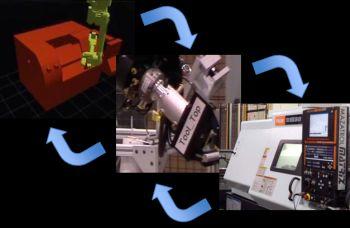Summary
Manufacturers are continually seeking ways to make factories more efficient, often through the use of robots, but integration of robots into existing facilities can be difficult and expensive. This integration is impeded by the inability of robots to easily communicate with devices and sensors for perception, mobility, and manipulation. To be fully successful, robotic systems need to achieve automated assembly at the level of human performance. Solving this integration problem is difficult due to the poorly-understood nature of the underlying information. Human assembly experts rely on training and experience using a wide range of sensing such as sight, touch, and sound in noisy and unstructured environments. This knowledge must be extracted into forms that can be exchanged and used in automated robotic assembly systems. Currently, these systems rely on custom hardware and software that are tailored to work in simple, constrained environments, with people enlisted to handle difficult tasks involving flexible materials, subtle alignment, and adroit fastening. The central idea of the project is to model the underlying information required to automate the composition and integration of complex robotic assembly systems, delivering an analysis, information model, protocol, software reference implementation, and test tools that enable manufacturers to quickly and easily put together robotic assembly systems with human capabilities using interoperable components. This benefits large manufacturers and small job shops alike, both of which must continually reconfigure their production systems in response to dynamic market changes. Vendors of next-generation robots, perception systems, mobility platforms, and manipulation technologies also benefit through the elimination of barriers to widespread adoption of their products, ensuring that the U.S. continues its manufacturing lead in these new areas.
Description

Objective: Enable manufacturers to quickly and easily put together robotic assembly systems with human-like capabilities using interoperable components, by delivering an analysis, information model, protocol, reference implementation, test methods, and tools.
Technical Idea: Making it easier for manufacturers to put together fully-integrated robotic workcells requires standards for the interfaces between all the components. These standards are in place today for simple assembly systems, but lack support for the advanced assembly operations that are needed to make the breakthrough improvements in assembly time and cost to remain globally competitive. This new information spans high-speed, real-time sensor data through non-real time models of high-level assembly objectives. Specifically, NIST will work with industry groups and standards developers to identify the new
information needs, define information models, and revise existing standards or publish new standards as appropriate.
Research Plan: To successfully carry out the technical plan, NIST will:
- Conduct a standards gap analysis to identify information needs. This assessment will serve as the basis for prioritizing subsequent work.
- Develop information models as revisions to existing standards or as the basis for new standards. The principal output of this work will be formal information models, and publications describing the research leading to these models.
- Validate the information models in testbed activities with cooperative agreement participants and industrial partners. This activity will likely result in changes to the preceding information models, an iterative process intended to improve the final results.
- Work with standards development organizations to publish these revisions or new standards.
Software developed by NIST during the course of these activities will be made available to implementers to accelerate the commercialization of systems that conform to these new standards.

